 Afrikaans
Afrikaans  Albanian
Albanian  Amharic
Amharic  Arabic
Arabic  Armenian
Armenian  Azerbaijani
Azerbaijani  Basque
Basque  Belarusian
Belarusian  Bengali
Bengali  Bosnian
Bosnian  Bulgarian
Bulgarian  Catalan
Catalan  Cebuano
Cebuano  Corsican
Corsican  Croatian
Croatian  Czech
Czech  Danish
Danish  Dutch
Dutch  English
English  Esperanto
Esperanto  Estonian
Estonian  Finnish
Finnish  French
French  Frisian
Frisian  Galician
Galician  Georgian
Georgian  German
German  Greek
Greek  Gujarati
Gujarati  Haitian Creole
Haitian Creole  hausa
hausa  hawaiian
hawaiian  Hebrew
Hebrew  Hindi
Hindi  Miao
Miao  Hungarian
Hungarian  Icelandic
Icelandic  igbo
igbo  Indonesian
Indonesian  irish
irish  Italian
Italian  Japanese
Japanese  Javanese
Javanese  Kannada
Kannada  kazakh
kazakh  Khmer
Khmer  Rwandese
Rwandese  Korean
Korean  Kurdish
Kurdish  Kyrgyz
Kyrgyz  Lao
Lao  Latin
Latin  Latvian
Latvian  Lithuanian
Lithuanian  Luxembourgish
Luxembourgish  Macedonian
Macedonian  Malgashi
Malgashi  Malay
Malay  Malayalam
Malayalam  Maltese
Maltese  Maori
Maori  Marathi
Marathi  Mongolian
Mongolian  Myanmar
Myanmar  Nepali
Nepali  Norwegian
Norwegian  Norwegian
Norwegian  Occitan
Occitan  Pashto
Pashto  Persian
Persian  Polish
Polish  Portuguese
Portuguese  Punjabi
Punjabi  Romanian
Romanian  Russian
Russian  Samoan
Samoan  Scottish Gaelic
Scottish Gaelic  Serbian
Serbian  Sesotho
Sesotho  Shona
Shona  Sindhi
Sindhi  Sinhala
Sinhala  Slovak
Slovak  Slovenian
Slovenian  Somali
Somali  Spanish
Spanish  Sundanese
Sundanese  Swahili
Swahili  Swedish
Swedish  Tagalog
Tagalog  Tajik
Tajik  Tamil
Tamil  Tatar
Tatar  Telugu
Telugu  Thai
Thai  Turkish
Turkish  Turkmen
Turkmen  Ukrainian
Ukrainian  Urdu
Urdu  Uighur
Uighur  Uzbek
Uzbek  Vietnamese
Vietnamese  Welsh
Welsh  Bantu
Bantu  Yiddish
Yiddish  Yoruba
Yoruba  Zulu
Zulu steel guide roller
Understanding Steel Guide Rollers An Overview
Steel guide rollers play a vital role in various industrial applications, particularly in the fields of manufacturing, material handling, and transportation. These components are designed to facilitate smooth movement and alignment of materials, ensuring efficiency and precision in operations. In this article, we will explore the significance, types, advantages, and maintenance of steel guide rollers.
Significance of Steel Guide Rollers
Steel guide rollers are essential in scenarios where heavy materials need to be moved or processed along a conveyor system or machinery. Their primary function is to support and guide materials, reducing friction and wear during transport. This is particularly crucial in industries such as mining, construction, and manufacturing, where heavy loads are common. By ensuring the proper alignment and movement of materials, guide rollers contribute to enhanced productivity and minimized downtime due to equipment failure.
Types of Steel Guide Rollers
There are several types of steel guide rollers available, each designed to suit specific applications and environments
1. Standard Guide Rollers These are the most commonly used type and are suitable for a range of applications. They typically feature a simple cylindrical design that allows for straightforward installation and maintenance.
2. Adjustable Guide Rollers These rollers can be adjusted to accommodate different material sizes and shapes. Their versatility makes them popular in industries that deal with a variety of products.
3. Heavy-Duty Guide Rollers Designed to withstand extreme loads and harsh conditions, heavy-duty guide rollers are built with robust materials and often feature enhanced bearing capacities. They are ideal for use in mining and construction environments.
4. Custom Guide Rollers In some cases, standard rollers may not meet specific requirements, prompting the need for custom-designed rollers. Manufacturers can create guide rollers tailored to unique specifications, ensuring optimal performance in specialized applications.
Advantages of Steel Guide Rollers
The use of steel guide rollers presents several advantages that enhance operational efficiency
steel guide roller

1. Durability Steel is renowned for its strength and resistance to wear and tear. Steel guide rollers are built to last, even in challenging environments, significantly extending their lifecycle and reducing replacement costs.
2. Reduced Friction By providing a smooth surface for materials to glide along, steel guide rollers minimize friction. This not only prevents damage to the materials being transported but also reduces the energy requirement for machinery, leading to cost savings.
3. Improved Precision Accurate alignment of materials is crucial in many manufacturing processes. Steel guide rollers help maintain this precision, ensuring that products are moved and processed correctly, which can significantly enhance quality control.
4. Ease of Maintenance Most steel guide rollers are designed with convenience in mind. They often feature easy-to-access components for lubrication and adjustments, making maintenance tasks simpler and quicker.
Maintenance of Steel Guide Rollers
To ensure optimal performance and longevity of steel guide rollers, regular maintenance is vital. Here are some maintenance tips
1. Routine Inspection Regularly check for signs of wear, misalignment, or damage. Early detection can prevent minor issues from escalating into significant problems.
2. Lubrication Keeping the rolling surfaces well-lubricated reduces friction and wear. Use appropriate lubricants as recommended by the manufacturer.
3. Cleanliness Keep the guide rollers free from debris, dust, and other contaminants that could impede their function. Regular cleaning helps maintain their efficiency.
4. Proper Alignment Ensure that the rollers are correctly aligned to prevent uneven wear and operational issues. Misalignment can lead to increased friction and degradation of both the rollers and the materials being transported.
Conclusion
Steel guide rollers are indispensable components in many industrial applications, enhancing the efficiency and reliability of material movement. Understanding the types, advantages, and maintenance of these rollers can help industries maximize their productivity and minimize operational costs. By investing in quality steel guide rollers and adhering to proper maintenance practices, businesses can ensure smooth and efficient operations in a competitive marketplace.
-
Revolutionizing Conveyor Reliability with Advanced Rubber Lagging PulleysNewsJul.22,2025
-
Powering Precision and Durability with Expert Manufacturers of Conveyor ComponentsNewsJul.22,2025
-
Optimizing Conveyor Systems with Advanced Conveyor AccessoriesNewsJul.22,2025
-
Maximize Conveyor Efficiency with Quality Conveyor Idler PulleysNewsJul.22,2025
-
Future-Proof Your Conveyor System with High-Performance Polyurethane RollerNewsJul.22,2025
-
Driving Efficiency Forward with Quality Idlers and RollersNewsJul.22,2025





























